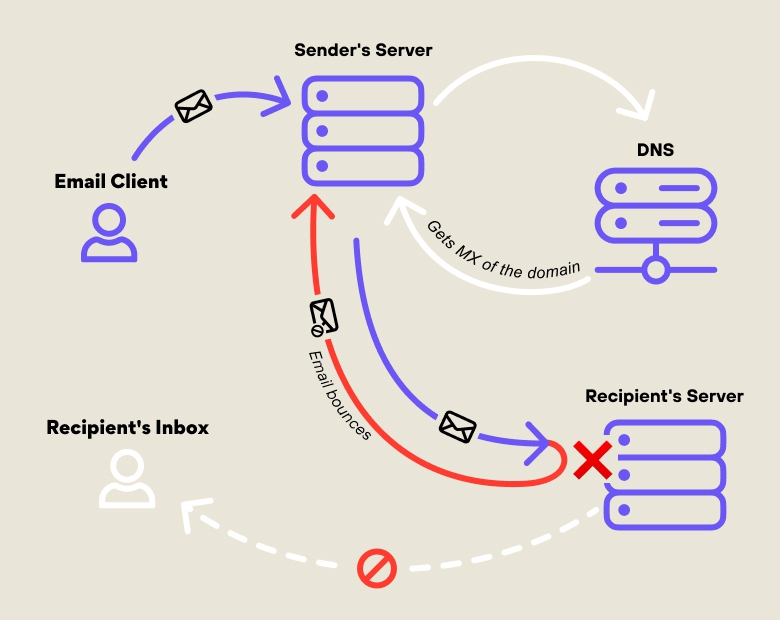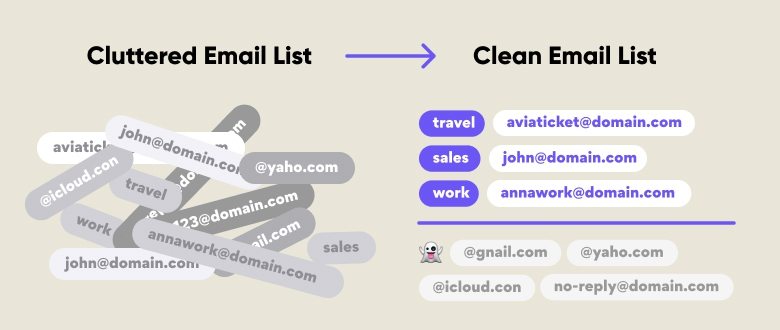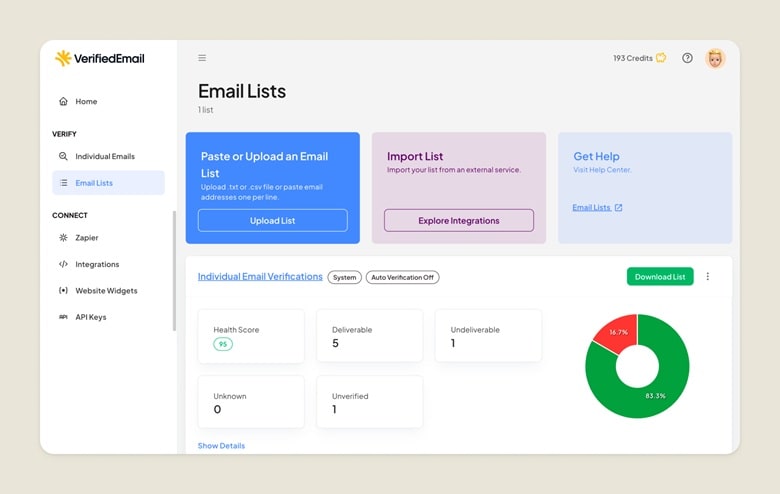You calculate ROI by subtracting campaign costs from the revenue earned, dividing by the cost, and multiplying by 100 to get a percentage.
Email Marketing ROI: How To Calculate, Benchmark, And Boost
Email marketing remains a highly effective channel for generating returns, but its success hinges significantly on the quality of your distribution lists. This article explores how email verification can boost your email marketing ROI by ensuring your messages reach the right audience.
What is ROI in Email Marketing?
Email marketing remains a powerful tool for bringing return on investment(ROI) into any marketing campaign. Because of the one-on-one nature of emails, marketers aiming to engage audiences directly leverage emails as they can send tailored messages relevant to the reader's engagement and needs—at least compared to other digital marketing channels like social media.
Average ROI for email marketing
The ROI for email marketing can vary widely depending on the industry, target audience, and the campaign. However, it's often cited as one of the highest among digital marketing channels. On average, businesses can expect an ROI of about $36 for every $1 spent.
This average email marketing ROI is due to the relatively low cost of sending emails compared to other forms of advertising. Add to that the channel's ability to directly reach and engage with a targeted audience.
What factors affect ROI?
Factors such as list quality, personalization, and content relevance can significantly influence the actual ROI achieved.
A clean, verified email list ensures your emails reach real people, while personalization and segmentation help deliver messages that feel relevant. Timing, subject lines, and mobile optimization also play a role, because even the best content may underperform if it lands at the wrong moment or isn’t easy to read on every device.
Such a tailored approach leads to more engagement and response rates from readers when they resonate with the message.
How to Calculate ROI for Email Marketing?
The basic formula is straightforward: Subtract the campaign's cost from the revenue generated, divide that number by the cost, and multiply by 100 to get a percentage.
Here's how it looks:
ROI (%) = [(Revenue attributed to the campaign - Cost associated with email marketing) / Cost associated with email marketing] x 100
For example, if your campaign generated $1,000 in revenue and cost $100, the calculation would be:
ROI (%) = [($1,000 - $100) / $100] x 100 = 900%
Some marketing software has an email marketing ROI calculator that computes the ROI for you. All you need to do is input your specific campaign costs and revenue figures.
Common Challenges in Email Marketing That Affect ROI
Email marketing comes with its challenges. Some tricky things can drastically affect the ROI if not properly managed, like the following:
High Bounce Rates
A bounced email occurs when a message cannot be delivered to the recipient's inbox. There are two types: hard bounces, which happen when an email address is invalid, and soft bounces, which occur due to temporary issues like a full inbox.

Bounce rates are a significant concern. High bounce rates indicate poor deliverability and can lead to lower ROI.
A common mistake many marketers make is not routinely cleaning their email lists, which results in sending messages to uninterested or inactive recipients. This is where bulk email cleaning tools come in handy; they remove the tedious task of manually cleaning the distribution list and ensure contacts remain valid in real time.

Purchased lists are another cause (more common than we want to see) for high bounce rates. A rather unnecessary practice for marketers, purchased lists often contain outdated or irrelevant contacts, leading to high bounce rates and low engagement.
Spam Complaints and Unsubscribe Rates
These two things are symptoms of audience dissatisfaction. Spam complaints can arise from irrelevant or excessive sending of messages. High unsubscribe rates often point to issues with targeting or content relevance. Both can be detrimental to your campaign's effectiveness and ROI.
When subscribers mark your messages as spam or opt to unsubscribe, it signals dissatisfaction with your content or frequency. This signals your marketing software or email service of deliverability issues and can cause reduced campaign effectiveness.
To minimize these issues, focus on crafting relevant and personalized content for your audience. Ensure you have asked for proper consent through clear opt-in processes, as this sets the foundation for a positive subscriber relationship. Regularly assess the content you send to align with your subscribers' interests and needs.
Poor Engagement Metrics
Low open and click-through rates are email marketing metrics that indicate poor engagement. When recipients don't interact with your messages, it suggests that your content isn't resonating or reaching the right people. This lack of engagement not only diminishes current campaign results; it can also affect your future content and even reputation, both important to achieving a decent ROI.
To enhance engagement, focus on segmenting your audience and personalizing your content. By dividing your subscribers into specific groups based on their behaviors or preferences, you can tailor your messages to meet their needs better.
Avoid sending generic emails to all subscribers. This one-size-fits-all approach often results in low engagement, as it fails to address the diverse interests of your audience.
Also, a frequent mistake is ignoring data analytics. Without analyzing performance data, marketers miss valuable insights that could guide their strategies and boost engagement. Leverage data to conduct A/B tests (on subject lines or content), optimize send times, and know which dynamic content can help tailor your messages further.
How Can I Improve My Email Marketing ROI
Improving ROI in email marketing comes down to three essentials: reaching the right people, keeping them engaged, and making every send count. This means focusing on deliverability, list quality, and audience relevance.
One of the most effective ways to achieve this is by using email verification, which ensures your messages land in valid inboxes and drive real engagement.
Improved Deliverability
Email verification removes invalid or non-existent addresses. With higher email deliverability comes a more solid sender reputation — increasing the likelihood of your recipients getting, opening and reading your messages, and engaging with your campaign.
Better Data Quality
Accurate data from a verified list enables more precise targeting and personalization. With correct contact details come better customization and tailored messages, which can enhance the effectiveness of your campaigns and drive higher ROI.
Enhanced Engagement
With a verified list, you can focus on delivering tailored messages for recipients more likely to engage with your content — leading to higher open rates and click-through metrics. Higher engagement typically translates into better conversion rates, positively impacting your ROI.
Cost Efficiency
Sending messages to invalid addresses wastes resources. Email verification helps you avoid these unnecessary costs. Instead, it allows you to allocate your budget more effectively and maximize your marketing spend. Verified emails enable you to focus your resources on a refined list of responsive subscribers.
Using Email Verification Tools
Using tools like VerifiedEmail can help you improve deliverability and reduce bounce rates, safeguarding your sender's reputation. Continuous list maintenance ensures your lists remain clean and optimized over time — in real time!
VerifiedEmail is a leading solution for fast and accurate email verification and list cleaning, designed to enhance marketing efficiency. Offering real-time email validation and bulk list cleaning capabilities, VerifiedEmail ensures that your messages reach valid recipients with precision and security.

Our proprietary infrastructure allows for competitive pricing without compromising quality, making it an affordable choice for businesses of all sizes.
Conclusion
Email verification is a game-changer for anyone serious about email marketing. It tackles the usual hurdles, like making sure your messages get delivered, keeping your audience engaged, and staying cost-effective.
By using tools like VerifiedEmail, your campaigns can see a real boost in ROI — driving better email marketing outcomes and ensuring you're on top of your distribution list's growth. Key metrics include open rates, click-through rates, conversion rates, bounce rates, and revenue generated per email. On average, businesses earn about $36 for every $1 spent, though results vary by industry and audience. In B2B, a strong ROI often falls between 30:1 and 40:1, depending on the sales cycle length and lead quality. Maintain a clean list with email verification, personalize your content, test subject lines and send times, and focus on audience segmentation. Email Marketing ROI – FAQs
Verify 200 emails for free. For lists over one-million emails, we will beat the price of any competitor, guaranteed.

